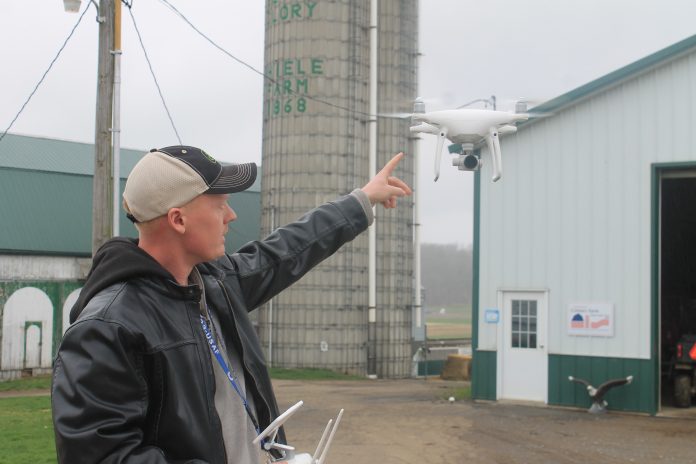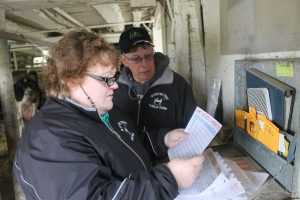
CABOT, Pa. — William Thiele received his first drone for Christmas in 2015. He started using it to record their field work and quickly became obsessed.
“An aerial view gives you the best look at a field. It isn’t a toy, it’s a tool,” he said.
For example, they harvest rye to replant the next year, and by using the drone, they can determine which field and which sections of the field to use for seed.
“It is a very different perspective,” William said. “The color of the field changes if it is dry or wet.”

The Thieles — William, his twin, James, mother Lorraine, and father Ed — work together to make such decisions on their dairy farm in Butler County, Pennsylvania.
They farm around 300 acres, which includes rented land, and grow corn, soybeans, alfalfa grass, oats and a variety of cover crops. The majority of what they grow is fed to their dairy herd.
#droneguy
With the drone, they check on their cows, groundhog traps and field conditions.
Since the original, gifted drone, William has purchased a more sophisticated drone, or unmanned aircraft system, that averages 30-35 mph, but William said his has gone up to 50 mph with a tailwind.
Drones are supposed to be only 400 feet in the air and remain in sight, but the drone does have the ability to fly a distance of 4 miles, horizontally.
His drone also has forward and backward sensing to avoid hitting objects, and when it is about to run out of batteries, it starts to head home, whether or not you tell it to.
“It’s like a quality camera with wings,” he said.
When he isn’t feeding or milking the cows, Thiele has become the #droneguy off the farm, too, doing weddings, aerial farm shots, and taking photos and videos for other marketing efforts.
Drones are making their way into the ag industry, with some crop insurance companies using them to verify claims, and some farmers are using satellite images with infrared, Normalized Difference Vegetation Index, he said.
“With that technology, they may have five satellite images, but there is no zooming. With a drone, you could check it every day and see the field in real time,” he said.
This is the 2017 Social Media Contest award winning video that William Thiele and James Thiele created about their farm. The contest was to create a 5 minute video talking about their farm and what modern agricultural practices they use. They won a trip to the 2018 AFBF YF&R Leadership Conference!! #pfbproud
Posted by Butler County Farm Bureau PA on Friday, December 8, 2017
UAS regulation
For some, the word drone brings to mind a violation of privacy or a need for regulation. To operate his, William has earned a 107 certificate from the Federal Aviation Administration.
To be awarded this certificate, one must take a 60-question test at a local airfield, costing $150. You also have to answer 70 percent of the questions correctly to pass, William said.
Unmanned Aircraft Systems
Registration
Owners must be 13 or older.
Owners must register their UAS if it weighs between 0.55 and 55 pounds.
Any UAS weighing in excess of 55 pounds must be registered with the FAA as an aircraft.
Operating
There are restrictions in place that limit how you can and cannot operate your UAS.
The UAS must remain within the operator’s line of sight.
No flights are permitted over pedestrians, moving vehicles, public infrastructure, or within 25 feet of private property.
If operating within five miles of an airport, UAS activity must be coordinated with airport management.
To help UAS operators know where they can and cannot operate their UAS, the FAA has developed the B4UFly smartphone app that helps you determine whether there are any restrictions or requirements in effect at the location where you want to fly.
For more information visit www.faa.gov/uas/
Source: http://www.penndot.gov/Doing-Business/Aviation
Once certified, drone pilots have to retake the test every two years to remain certified. All drones used for recreation, commercial or government use have to be registered and display their registration number. (See sidebar for more UAS regulations)
On the farm
At the Thiele Dairy, aerial imagery has improved crop scouting and plant growth and stress evaluation, said Ed Thiele, who has gotten used to making farm decisions based on drone images.
They have turned photos into support for farm decisions, some of which have saved them money, as they look for ways to decrease costs as the dairy industry suffers.
“You have to play the cards you are dealt,” Ed said.
They milk 40 cows twice a day in tie-stalls. The barn was built in 1864, but remodeled in 2000. They built a new heifer barn in 2017 with the help of Natural Resources Conservation Service and Butler County Conservation District cost-share programs.
“We make decisions around here based on what is best for the cows — they will pay you back.”
They pride themselves on individual care, examining records and serving each cow’s needs.
They surround themselves with experts, their nutritionist, veterinarian and breeding adviser. The Thieles talk with these team members, taking their advice and making their farm better.
Investing in the land
The Thieles have great regard for their cows and their land, as they were the first farm in Butler County to place their land in the state’s farmland preservation program.
They made that decision in 1997, and since then, more than 50 farms in the county have followed their lead. Ed Thiele wants to leave the ground better than he found it, he said, as the sixth generation is now working on the farm.
Ed worked with NRCS to get a grant to plant cover crops and quickly was doing research and getting excited about trying different covers.
“You have to think of it in the long term, putting an IRA on your soil,” Ed says about his use of cover crops.
“Without your soil, you are nothing. This is a no-brainer.”

The Thieles planted green for the first time in 2017 and were “pleasantly surprised.” They planted corn, rolled the rye cover crop and then sprayed all in the same day.
“The yield was every bit as good as before, and the rye laid down and acted like a natural mulch,” Ed said.
They hosted an NRCS crop day on the farm last July to talk about their experiences and show attendees drone footage of the field work.
“That was the point I realized I was really drinking the Kool-Aid,” he said, as his interest in cover crops evolved into advocacy.
They have planted buckwheat, radishes, sunflowers, sunn hemp, rapeseed, hairy vetch, fields peas and the list keeps growing.
“I like trying off-the-wall stuff.”
They have also planted cover crops as late as the first week of December when they harvested the last of their beans. And it sprouted in the spring.
Plowing is a disservice to the habitat, Ed said.
“We used to plow everything and get the seedbed nice and smooth. Now I’ve flipped a 180. Water doesn’t go through a plowed field like it does natural worm holes.”
He has even encouraged Lorraine to plant her flowers into green, she said. He doesn’t want to disrupt the soil anywhere.
“There are still times I think we need to work the ground; it was just instilled in me,” he said. Now the Thieles work the ground only if it has become compacted.

Hard times
“We’ve ridden through some bad prices in the past — but this is a new low,” Ed said. “If we didn’t have royalties and sell a few crops, I don’t know where we would be.”
“I don’t know the solution — the market is saturated with milk — some have to get out, we just hope it’s not us.”
Their silo reads “In God We Trust.”
“We’ve seen God work in our lives, and we trust in God to keep us here,” Ed said.









